American Journal of Plant Sciences
Vol.4 No.12A(2013), Article ID:41273,8 pages DOI:10.4236/ajps.2013.412A1009
Floristic Composition of the Plants of the Cholistan Desert, Pakistan
![]()
1Cholistan Institute of Desert Studies, The Islamia University of Bahawalpur, Bahawalpur, Pakistan; 2The Islamia University of Bahawalpur, Pakistan; 3Shakarpur Campus, Shah Abdul-Latif University, Khairpur, Pakistan.
Email: wariss0709@gmail.com
Copyright © 2013 Hafiz Muhammad Wariss et al. This is an open access article distributed under the Creative Commons Attribution License, which permits unrestricted use, distribution, and reproduction in any medium, provided the original work is properly cited.
Received October 25th, 2013; revised November 26th, 2013; accepted December 12th, 2013
Keywords: Floristic Composition; Life Form; Habit; Cholistan Desert; Pakistan
ABSTRACT
A floristic survey of Cholistan desert was carried out during 2009-2011 and total of 38 families, 106 genera and 154 species were documented from the area. Among families, 33 families belong to Dicotyledons of 79 genera and 115 species, while the 38 species of 26 genera belong to 4 families of Monocotyledons and 1 family of gymnosperms with 1 genus and 1 species. The largest family was Poaceae with 34 species followed by Papilionaceae and Zygophyllaceae with 10 species while Asteraceae with 9 species respectively. The life form of plant species was determined by following the Raunkier’s method. Therophytes comprised of 74 species (48%), Chamaephyte 40 species (26%), Hemicryptophyte 18 species (12%), Phanerophyte 19 species (12%) and Cryptophyte 3 species (2%) of the flroa of the area. It will be helpful and serve for the conservation and sustainable utilization of plant resources of the study area.
1. Introduction
The Cholistan desert covering an area of 26,000 km2, lies within South of Bahawalpur in the Punjab extending through the Nara and Thar deserts of Sindh between 27˚42ʹN and 29˚45ʹN latitude and 69˚52ʹE and 75˚24ʹE longitude (Figure 1) [1] at an altitude of about 112 m above sea level [2].
Historically, the Cholistan desert was a cradle of Hakra River Civilization which flowed through the area during 1200 BC regularly and became irregular about 600 BC. Cholistan received heavy monsoon downpours along with the Indus valley civilization including Mohenjo Daro and Harappa of world’s oldest civilization about 5000 years ago. Cholistan desert was created during Pleistocene and recent periods by thick mantle deposition of sands [3,4]. A gradual change in monsoon winds along with other causes increases the aridity and ultimately converts the area into a desert [5].
The climate of the Cholistan desert is sub-tropical, arid and semi-arid, scorching harsh, with monsoon rainfall influenced by periodic long droughts. The relative humidity is very low with high rate of evaporation [6]. The mean annual rainfall varies between 100 mm to 250 mm. The mean summer temperature is 34˚C - 38˚C, and the winter temperature is 15˚C - 20˚C with highest temperature reaching over 51.6˚C [7]. Topographically, the area can be divided into two geomorphic regions based on parent material, soil and vegetation. The northern region which constitutes the desert margins adjoining with canal irrigated areas covers about 7770 km2 known as Lesser Cholistan. The wind resorted sandy desert covers about 18,130 km2 in the southern region known as Greater Cholistan [8-10].
The soil of the Cholistan desert is very poor in having organic matters. The pH ranges between 8.6 and 10.0 saline and saline-sodic respectively. In Cholistan desert, two sources of water, one is rainfall and other is sub-soil water. Rain water is collected in “Tobas” man-made ponds or natural depression. The second source of water is underground water at the depth of 30 to 90 m. It is brackish and not fit for drinking and agriculture because it contains total dissolved salts about 9000 - 27,000 ppm mg/L [11]. The vegetation of Cholistan desert comprises of xerophytic species adapted to wide range of severe temperature, moisture and edaphic conditions. The dis-
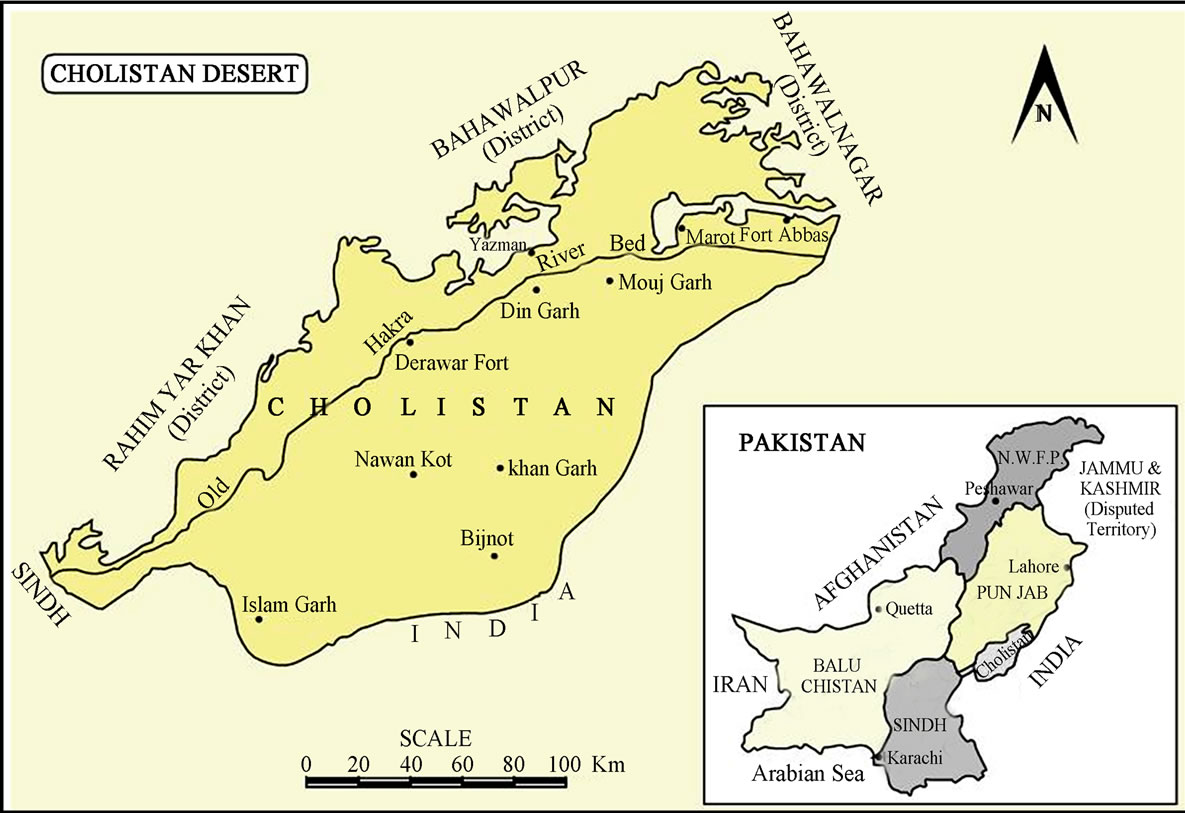
Figure 1. Location map of the Cholistan desert.
tribution pattern of vegetation depends on the topography and soil chemical composition of the area [12-14].
The local plants identification and introduction of an area is very important to introduce the specific species of the local area and their occurrence, growing season, finding new species and the effect of climatic conditions like drought and over-grazing on vegetation [10,15]. Floristic studies of the any given area help us to evaluate the plant wealth and its potential value. Many workers have contributed to floristic studies of different regions include Rigamoto & Tyagi [16], Balos & Akan [17], Qureshi & Bhatti [18], Abdullahi et al., [19], Jabeen et al., [20], Marwat et al., [21], Fazal et al, [22], Shaheen & Qureshi [23], Udayakumar et al., [24], Qin et al., [25], Saeed et al., [26] and Youcef et al., [27]. Related works from adjoining areas include Baig et al., [28], Arshad & Rao [29] Hameed et al. [30] Arshad et al., [31] and Wariss [32].
Because of the diverse topographic features and microhabitats, the study area had a great potential for flourishing a rich plant biodiversity. Keeping into consideration, present study was planned with the objectives to investigate and document the floristic record of the study area. It will be helpful and serve for the conservation and sustainable utilization of plant resources of the area.
2. Materials and Methods
The detailed field studies have been made to collect plant specimens at regular intervals during 2009-2011 in each season. During field visits, 5 plants of each species have been collected, dried and mounted on standard herbarium sheets. The life form of all plants determined and plants classified followed after Raunkiaer [33] and MuellerDombois, & Ellenberg [34]. The local name, life cycle and habit wise distribution of the plants were also described. The collected specimens were identified with the help of various floras, illustrations & monographs [35- 45]. The voucher specimens were deposited in the herbarium of Cholistan Institute of Desert Studies, The Islamia University of Bahawalpur.
3. Results and Discussion
The present study examines the flora of the Cholistan desert, which indicates that the flora of the Cholistan desert belongs to 154 plant species of 106 genera and 38 families. Among the existing families, 33 families are dicotyledons, 4 families of monocotyledons and 1 family of gymnosperms (Table 1). The largest family of the area is Poaceae with 34 species. Papailionaceae and Zygophyllaceae are with 10 species. Asteraceae is present with 9 species. Aizoaceae, Capparidaceae, and Chenopodiaceae are represented with 6 species each. Asclepiadaceae, Amaranthaceae and Solanaceae are represented with 5 species. The families with 4 species are Boraginaceae, Convolvulaceae, Cucurbitaceae, Euphorbiaceae and Mimosaceae. Brassicaceae, Cyperaceae, Molluginaceae, Nyctaginaceae, Polygonaceae and Rhamnaceae have 3 species each. Malvaceae, Portulaceae, Tamaricaceae and Tiliaceae are represented by 2 species. The rest of thirteen families are represented with one species.
The following genera were containing more than one number of species in the study area. The Genus Cenchres and Eragrostis were with 4 species. Aristida, Boerhavia,


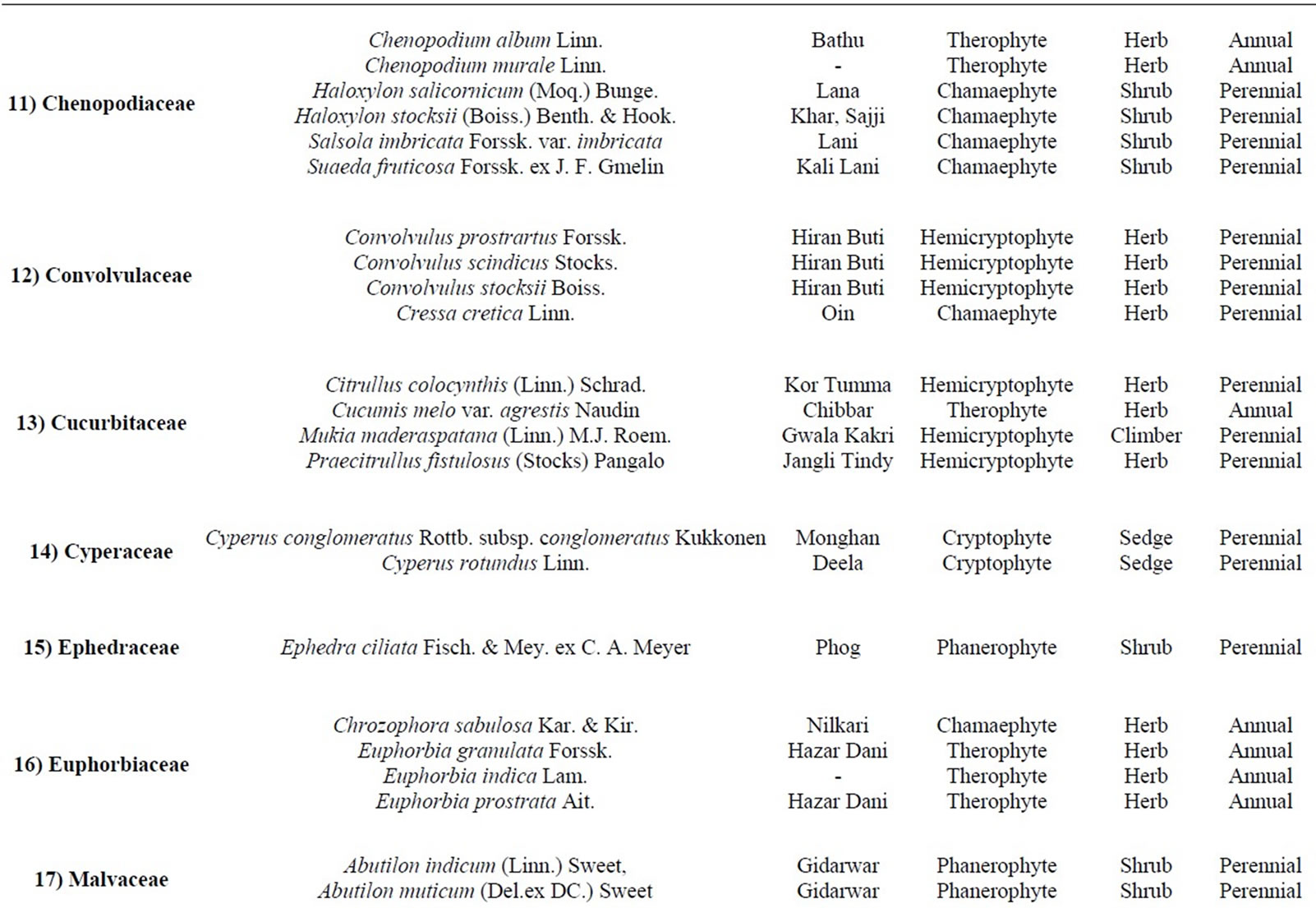

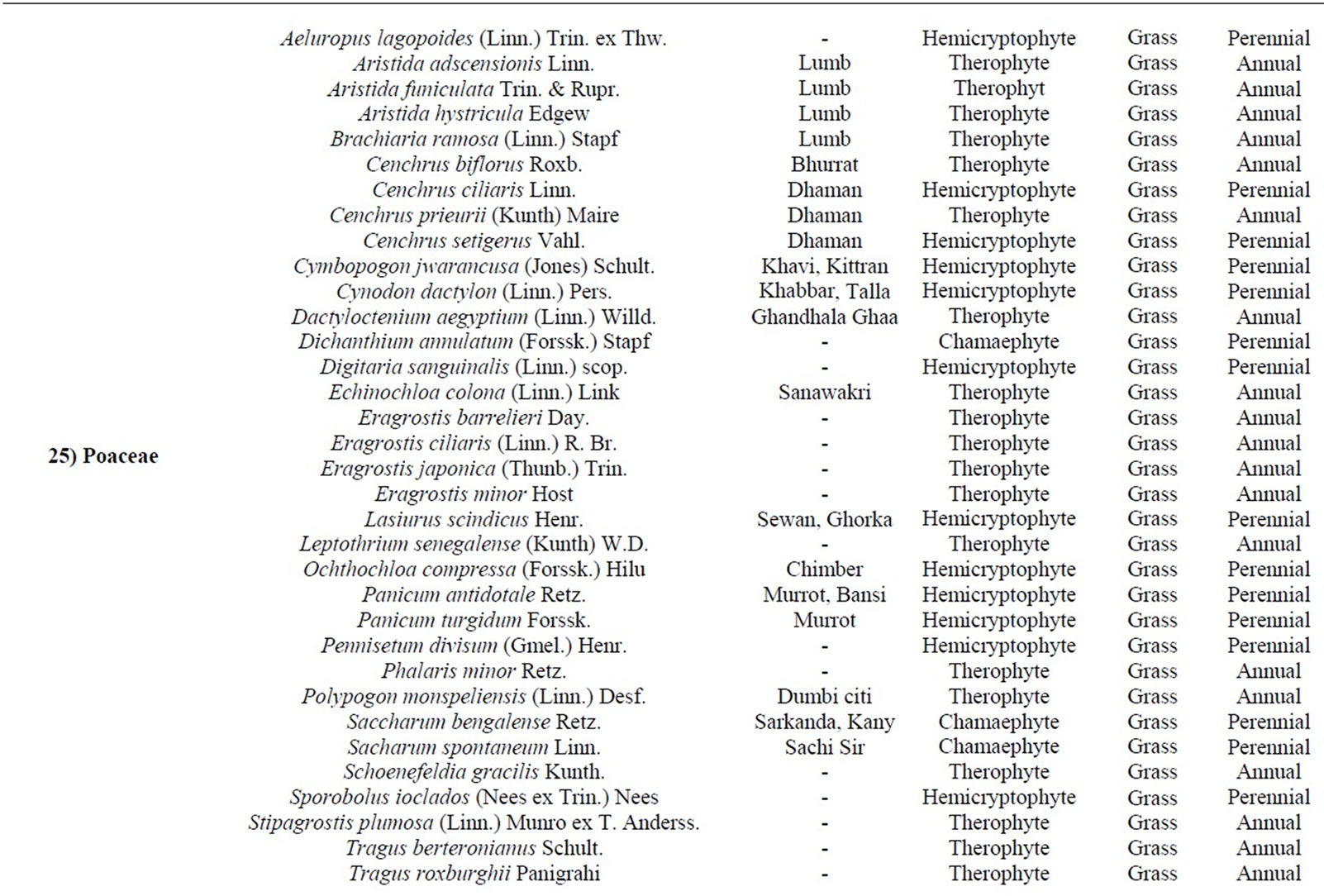

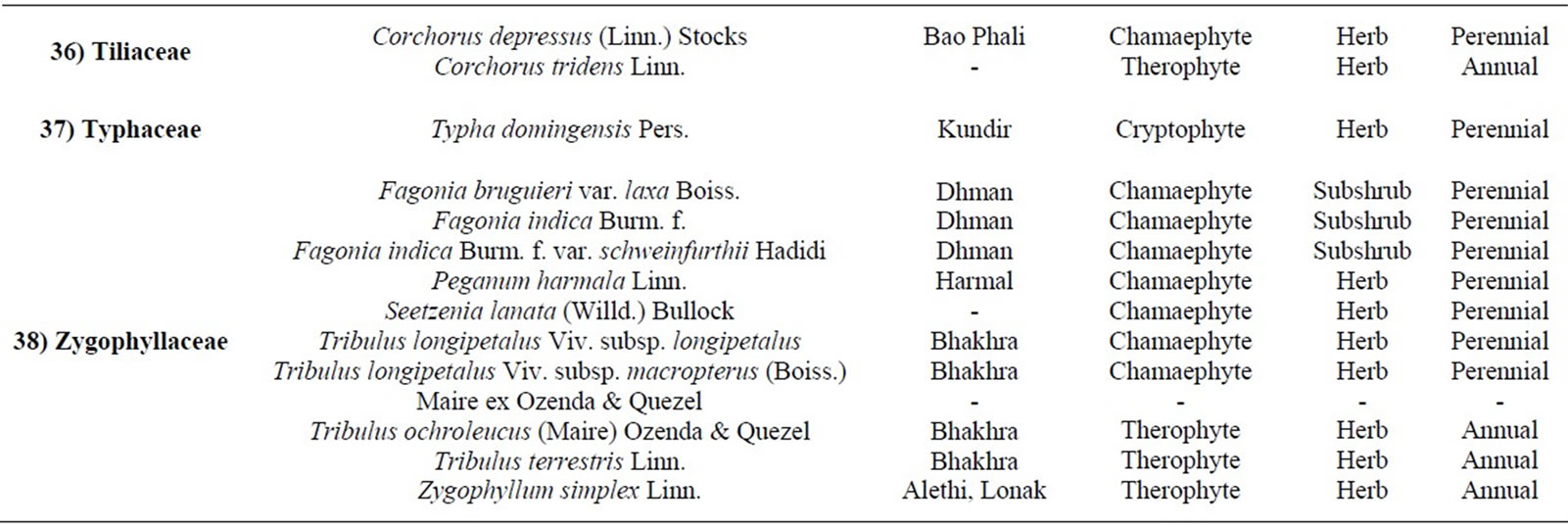
Table 1. List of plant species of Cholistan desert.
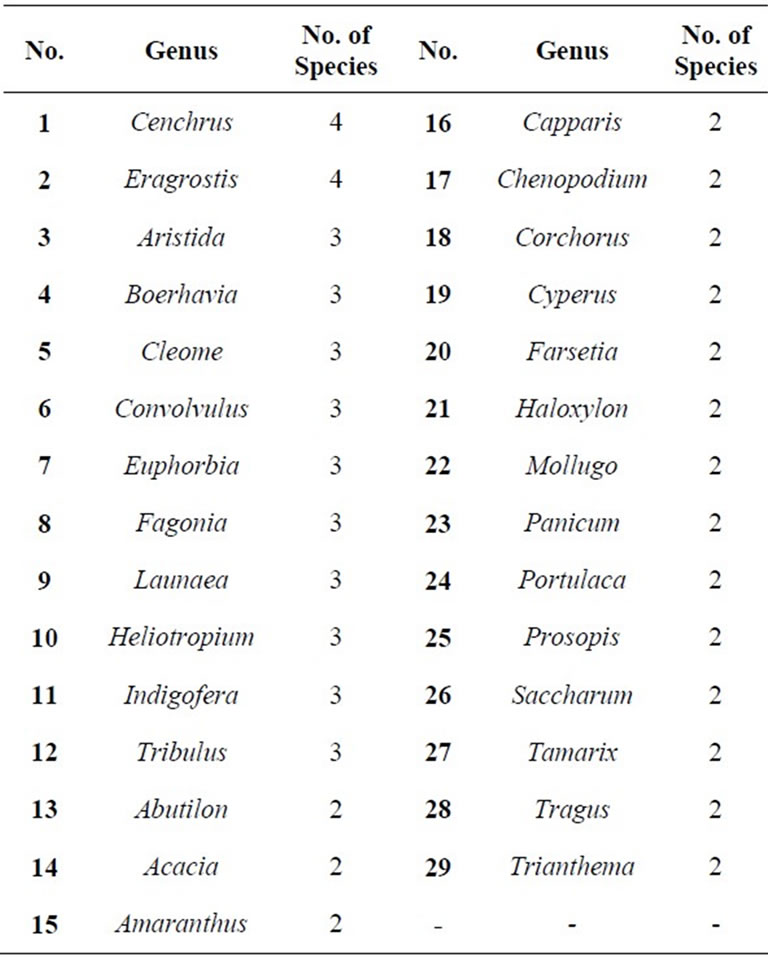
Table 2. Species total of the largest genera.
Cleome, Convolvulus, Euphorbia, Fagonia, Launaea, Heliotropium, Indigofera, Tribulus and Zizyphus each were with 3 species. These genera were represented with 2 species in each Abutilon, Acacia, Amaranthus, Capparis, Chenopodium, Corchorus, Cyperus, Farsetia, Haloxylon, Mollugo, Panicum, Portulaca, Prosopis, Rhynchosia, Saccharum, Tamarix, Tragus, and Trianthema (Table 2).
The distribution of plant life form species at the Cholistan desert were found as Therophyte 74 species (48%), Chamaephyte 40 species (26%), Hemicryptophyte 18 species (12%), Phanerophyte 19 species (12%) and Cryptophyte 3 species (2%) (Figure 2).

Figure 2. Life form distribution of plant species of Cholisitan desert.

Figure 3. Habit-wise distribution of plant species of Cholistan Desert.

Figure 4. Graphical respresntastion of life cycle of plant species of Cholistan desert.
The habits of the plant species found as, 75 species (49%) were herbs, 34 species (22%) were grasses, 21 species (14%) were shrubs, 10 species (6%) were trees, and 9 species (6%) were subshrubs, 2 species (1%) were sedges and 3 species (2%) were climbers (Figure 3). The life span or life cycle distribution of the plant species in the study area were represented by 79 species (51%) perennials and 75 (49%) annual species (Figure 4).
REFERENCES
- R. Akhter and M. Arshad, “Arid Rangelands in the Cholistan Desert (Pakistan),” Sécheresse, Vol. 17, No. 1, 2006, pp. 210-217.
- I. Ali, M. S. Chaudhary and U. Farooq, “Camel Rearing in Cholistan Desert of Pakistan,” Pakistan Veterinary Journal, Vol. 29, No. 2, 2009, pp. 85-92.
- R. C. Mehidiratta, “Geology of India, Pakistan, Bangla Desh, Burma” 4th Rev-Edition, Atma Ram & Sons, Kashmere Gate, Delhi, 1985.
- D. N. Wadia, “Geology of India,” Tata McGraw-Hill Publishing Co. Ltd., New Delhi, 1987.
- A. S. Leopold, “The Desert New York,” Time-Life International, New York, 1963.
- M. Arshad, M. Y. Ashraf, M. Ahmad and F. Zaman, “Mor- pho-Genetic Variability Potential of Cenchrus ciliaris L., from Cholistan Desert, Pakistan,” Pakistan Journal of Botany, Vol. 39, No. 5, 2007, pp. 1481-1488.
- M. Arshad, M. Ashraf and N. Arif, “Morphological Variability of Prosopis cineraria (L.) Druce, from the Cholistan Desert, Pakistan,” Genetic Resources and Crop Evolution, Vol. 53, No. 8, 2006, pp. 1589-1596. http://dx.doi.org/10.1007/s10722-005-8563-5
- G. Akbar, T. N. Khan and M. Arshad, “Cholistan Desert,” Pakistan Rangelands, Vol. 18, No. 4, 1996, pp. 124-128.
- S. A. Chaudhry, “The Cholistan Desert. A TOKTEN Con- sultancy Report,” Cholistan Institute of Desert Studies, Islamia University, Bahawalpur, 1992, p. 34.
- K. Ahmad, Z. I. Khan, M. Ashraf, M. I. Hussain and E. H. Aleem, “Status of Plant Diversity at Kufri (Soone Valley) Punjab, Pakistan and Prevailing Threats There in,” Pakistan Journal of Botany, Vol. 40, No. 3, 2008, pp. 993- 997.
- M. S. Baig, M. Akram and M. A. Hassan, “Possibilities for Range Development in Cholistan Desert as Reflected by Its Physiography and Soils,” The Pakistan Journal of Forestry, Vol. 30, No. 2, 1980, pp. 61-71.
- A. R. Rao, M. Arshad and M. Shafiq, “Perennial Grass Germplasm of Cholistan Desert and its Phytosociology,” Cholistan Institute of Desert Studies, Islamia University, Bahawalpur, 1989.
- M. Arshad and G. Akbar, “Benchmark of Plant Communities of Cholistan Desert,” Pakistan Journal of Biological Sciences, Vol. 5, No. 10, 2002, pp. 1110-1113. http://dx.doi.org/10.3923/pjbs.2002.1110.1113
- M. Arshad, H. Anwar, M. Y. Ashraf, S. Noureen and M. Moazzam, “Edaphic Factors and Distribution of Vegetation in the Cholistan Desert, Pakistan,” Pakistan Journal of Botany, Vol. 40, No. 5, 2008, pp. 1923-1931.
- S. I. Ali, “Significance of Flora with Special Reference to Pakistan,” Pakistan Journal of Botany, Vol. 40, No. 3, 2008, pp. 967-971.
- R. R. Rigamoto and A. P. Tyagi, “Biodiversity of the Coastal Littoral Vegetation of Rotuma Island, Fiji,” International Journal of Agriculture and Biology, Vol. 7, No. 1, 2005, pp. 79-81.
- M. M. Balos and H. Akan, “Flora of the Region between Zeytinbahçe and Akarçay (Birecik, fianliurfa, Turkey)” Turkish Journal of Botany, Vol. 32, No. 3, 2008, pp. 201-226.
- R. Qureshi and G. R. Bhatti, “Diversity of Micro-Habitats and Their Plant Resources in Nara Desert, Pakistan,” Pakistan Journal of Botany, Vol. 40, No. 3, 2008, pp. 979-992.
- M. B. Abdullahi, S. S. Sanusi, S. D. Abdul and F. B. J. Sawa, “An Assessment of the Herbaceous Species Vegetation of Yankari Game Reserve, Bauchi, Nigeria,” American-Eurasian Journal of Agricultural & Environmental Sciences, Vol. 6, No. 1, 2009, pp. 20-25.
- A. Jabeen, M. A. Khan, M. Ahmad, M. Zafar and F. Ahmad, “Indigenous Uses of Economically Important Flora of Margallah Hills National Park, Islamabad, Pakistan,” African Journal of Biotechnology, Vol. 8, No. 5, 2009, pp. 763-784.
- S. K. Marwat, M. A. Khan, M. Ahmad, M. Zafar, F. Ahmad and A. Nazir, “Taxonomic Studies of Nodulated Leguminous Weeds from the Flora of North Western part (Dera Ismail Khan) of Pakistan,” African Journal of Biotechnology, Vol. 8, No. 10, 2009, pp. 2163-2168.
- H. Fazal, N. Ahmad, A. Rashid and S. Farooq, “A Checklist of Phanerogamic Flora of Haripur Hazara, Khyber Pakhtunkhwa, Pakistan,” Pakistan Journal of Botany, Vol. 42, No. 3, 2010, pp. 1511-1522.
- H. Shaheen and R. A. Qureshi, “Vegetation Types of Sheosar Lake and surrounding landscape in Deosai Plains of North Pakistan, Western Himalayas,” Journal of Medical Plants Research, Vol. 5, No. 4, 2011, pp. 599- 603.
- M. Udayakumar, M. Ayyanar and T. Sekar, “Angiosperms, Pachaiyappa’s College, Chennai, Tamil Nadu, India,” Check List, Vol. 7, No. 1, 2011, pp. 37-48.
- X. Qin, R. Zhang and F. Xing, “A Study on the Flora and Vegetation of Cat Dua Island, Norteastern Vietnam,” Pakistan Journal of Botany, Vol. 44, No. 4, 2012, pp. 1229-1232.
- S. Saeed, R, Qureshi, M. A. Ullah and M. Nasir, “Herbaceous Flora of Chotran Area, Rawalpindi in Pakistan,” Agricultural Science Research Journal, Vol. 2, No. 6, 2012, pp. 312-317.
- H. Youcef, B. M. Lamine, B. Hocine, M. Rabah, L. Ali and M. B. Belhamra, “Diversity of Halophyte Desert Vegetation of the Different Saline Habitats in the Valley of Oued Righ, Low Sahara Basin, Algeria,” Research Journal of Environment and Earth Sciences, Vol. 4, No. 3, 2012, pp. 308-315.
- M. S. Baig, E. H. Khan, M. R. Zaheer and M. Ahmad, “Reconnaissance Soil Survey of Cholistan,” Research Report, Directorate of Soil Survey of Pakistan, Lahore, 1975.
- M. Arshad and A. R. Rao, “Flora of Cholistan Desert (Systematic List of Trees, Shrubs and Herbs),” Journal of Economic and Taxonomic Botany, Vol. 18, No. 3, 1994, pp. 615-625.
- M. Hameed, A. A. Chaudhary, M. A. Main and A. H. Gill, “Diversity of Plant Species in Lal Suhanra National Park, Bahawalpur, Pakistan,” Journal of Biological Sciences, Vol. 2, No. 4, 2002, pp. 267-274. http://dx.doi.org/10.3923/jbs.2002.267.274
- M. Arshad, G. Akbar and S. Rashid, “Wealth of Medicinal Plants of Cholistan Desert, Pakistan: Conservational Strategies,” Hamdard Medicus, Vol. XLV, No. 4, 2003, pp. 25-34.
- H. M. Wariss, “A Contribution to the Flora of Lal Suhanra National Park, Bahawalpur,” M.Sc. Thesis, Govt. College Bosan Road Multan, Multan, 2006.
- C. Raunkiaer, “The Life Forms of Plants and Statistical Plant Geography,” Oxford, 1934.
- D. Mueller-Dombois and H. Ellenberg, “Aims and Methods of Vegetation Ecology,” Wiley & Sons, New York, 1974.
- S. Ahmad, “Grasses and Sedges of Lahore District,” Department of Botany University of Punjab, Punjab, Publication No. 12, 1954, pp. 1-127.
- S. M. H. Jafri, “The Flora of Karachi,” Book Corporation, Karachi, 1996.
- S. A. Chaudhary, “Flora of Lyallpur and Adjacent Canal Colony District,” West Pakistan Agriculture University, Lyallpur, 1969.
- R. R. Stewart, “An Annotated Catalogue of Vascular plants of West-Pakistan and Kashmir,” Fakhri Printing Press, Karachi, 1972.
- K. M. Matthew, “Flora of Tamilnadu Carnatic,” The Rapinat Herbarium, St. Joseph’s College, Tiruchirapalli, 1981-1983, pp. 1-3.
- M. M. Bhandhari, “Flora of Indian Desert,” Scientific Publishers, Jodhpur, 1978.
- S. A. Chaudhary, “Grasses of Saudi Arabia,” National Agricultural and Water Research Center, Ministry of Agriculture and Water, Riadh, 1989.
- B. V. Shetty and V. Singh, V. “Flora of Rajasthan, Botanical Survey of India,” Vol. I & II, Old Connaught Place, Dehradun, 1987, 1991.
- Y. J. Nasir and R. A. Rafiq, “Wildflowers of Pakistan,” In: T. J. Roberts, Ed., Oxford University Press, Oxford, 1995, pp. 176-262.
- S. I. Ali and E. Nasir, “Flora of Pakistan, 01-215,” Department of Botany, University of Karachi, Karachi, 1970-2002.
- S. I. Ali and M. Qaiser, “Flora of Pakistan 194-210,” Department of Botany, University of Karachi, Karachi, 1993-to Date.

